CATHEDRAL QUEST
Our quest to experience the great cathedrals and churches of Europe
U.K. 2013 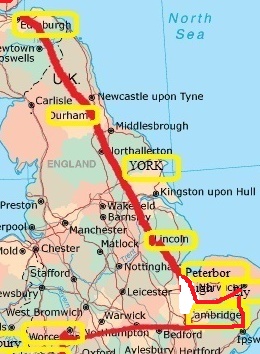
Day 13, Sunday
September 15, 2013
Cambridge
We had no fire/burglar alarm to wake us during the night. We woke up to bright sunshine and blue skies, which didn’t last long. It was very cold but we walked over to the train station and caught the 10:00 train to Cambridge.
It is only a 15 minute ride. The train station at Cambridge is a little distance from the center of town, so we took a taxi.
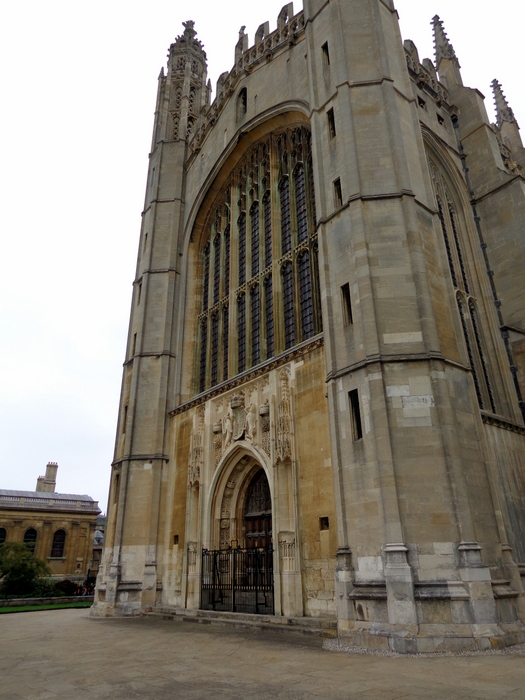 The driver dropped us in front of
Kings College. This was first on our
list today. Cambridge University is made up of 31 autonomous, self
governing communities. King’s College is one of the best known,
especially for its beautiful chapel with its wonderful fan vaulted
ceiling. It is the largest vault of its kind in the world. King Henry
VI laid the foundation stone in
The driver dropped us in front of
Kings College. This was first on our
list today. Cambridge University is made up of 31 autonomous, self
governing communities. King’s College is one of the best known,
especially for its beautiful chapel with its wonderful fan vaulted
ceiling. It is the largest vault of its kind in the world. King Henry
VI laid the foundation stone in
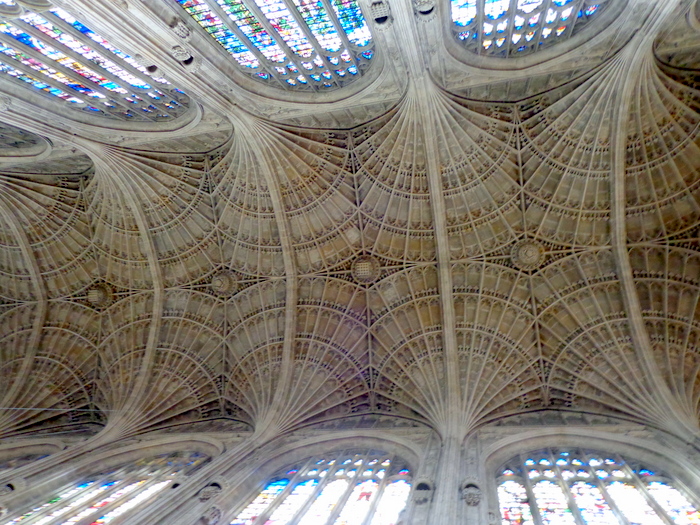 1446. It took five kings, four master
masons, and an army of craftsmen over a century to build King's College
Chapel.
1446. It took five kings, four master
masons, and an army of craftsmen over a century to build King's College
Chapel.
The interior of the Chapel is breathtaking with its magnificent fan
vaulted ceiling. Every surface is ribbed and groined and richly
decorated. The central bosses of alternating roses and porticullises
are carved from solid stone
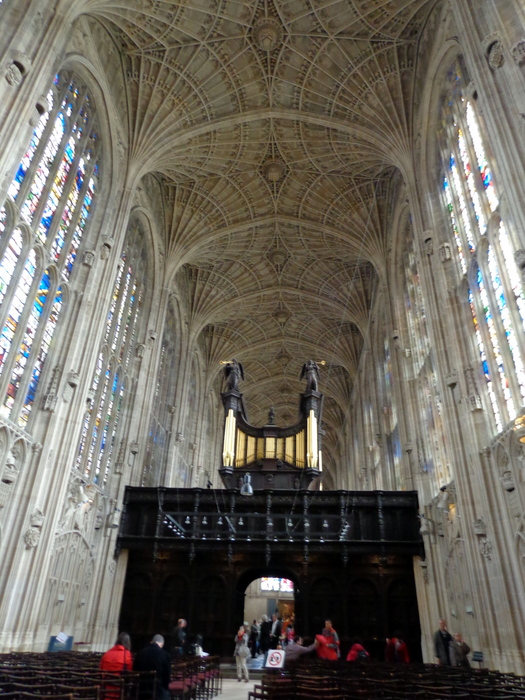 and each one weighs one ton.
and each one weighs one ton.
In addition to the magnificent fan vault ceiling, King's College Chapel is
also known for its intricate carvings and the remarkable choir screen.
Dividing the Chapel into antechapel and choir, the impressive screen,
carved from dark oak with its many interesting coats of arms, emblems
and ornamental decorations is an excellent example of Tudor woodwork.
The screen was a gift f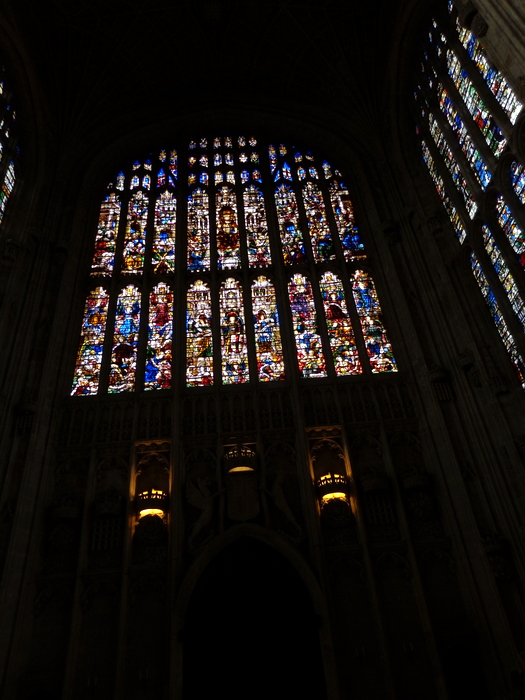 rom Henry VIII. Above the screen are the casings
which hold the organ pipes, dating from the early 1600s.
rom Henry VIII. Above the screen are the casings
which hold the organ pipes, dating from the early 1600s.
The exquisite stained-glass windows of the Chapel are the most complete
set of church windows surviving from the time of Henry VIII. There are
26 great windows, running from the north side of the chapel to the East
window, and then down the south side to the West window.
 The windows
depict scenes from the Old Testament and from the life of Christ.
The windows
depict scenes from the Old Testament and from the life of Christ.
With the exception of one period in history, when choral services at the
chapel were suppressed by the Puritans, the Choir has been singing
services continually for over 500 years, the Choir being older than the
Chapel itself. In modern times, the Choir has achieved international
renown through its recordings, concert tours, and radio and television
appearances. The famous Festival of Nine Le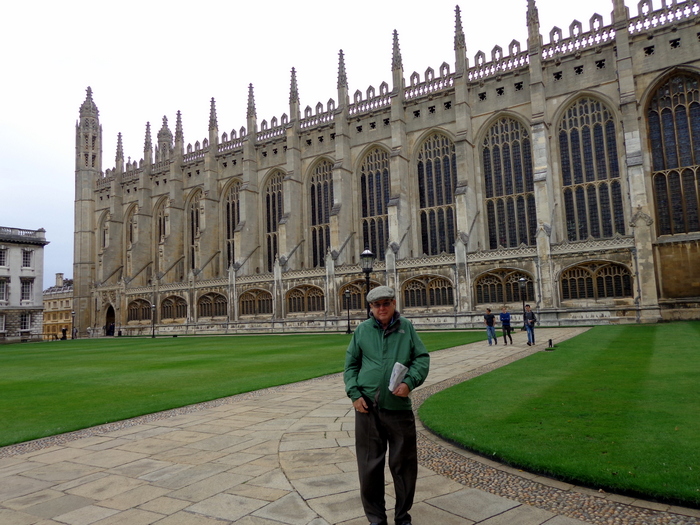 ssons and Carols was
instituted on Christmas Eve in 1918. Since 1928 it has been broadcast
around the world on Christmas Eve, and a televised version was first
shown in 1954.
ssons and Carols was
instituted on Christmas Eve in 1918. Since 1928 it has been broadcast
around the world on Christmas Eve, and a televised version was first
shown in 1954.
The chapel measures 288 feet long, 40 feet wide and 90 feet high. There
were so many beautiful windows and
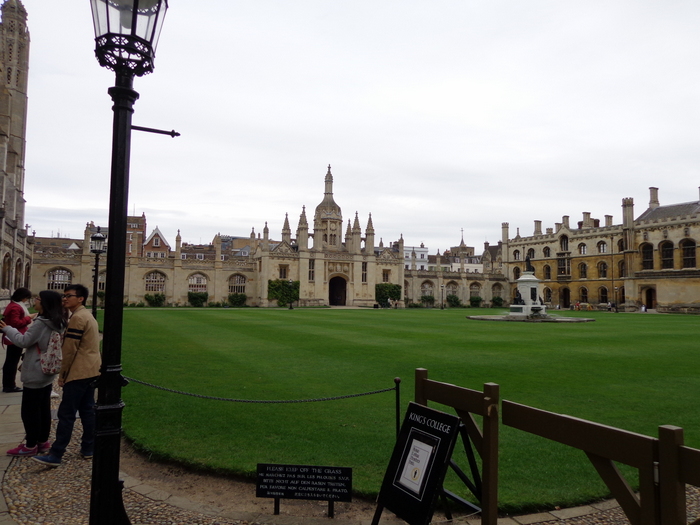 carvings to admire, we could have
spent the entire day there.
carvings to admire, we could have
spent the entire day there.
Once outside, we walked around the court which has dorms and classrooms on three sides, sometime all four sides. There is one rule- you can never walk on the grass. Each of the four corners of the Chapel has a octagonal turrets. On each side are 12 bays with 11 buttresses.
It was getting close to noon, so
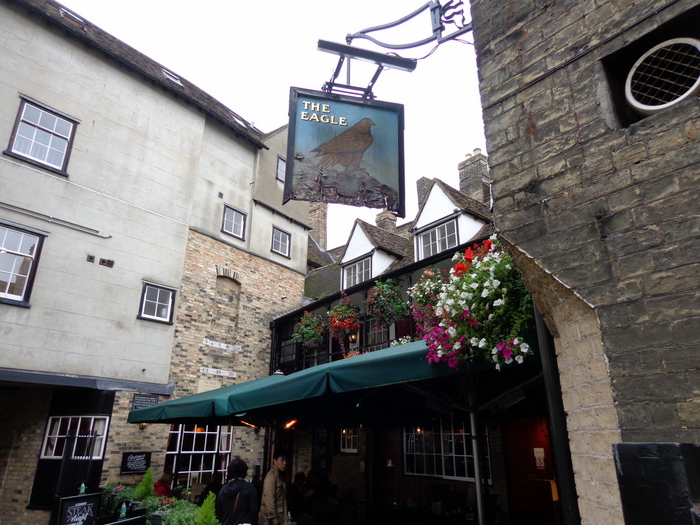 we decided to have lunch at the Eagle
Pub, which was originally opened in 1667. It looks like an old pub as
there are many rooms. In the back bar, there is a ceiling signed by the
RAF and Americans soldiers during WWII, who wrote their names and
graffiti on the ceilings. When the University's Cavendish Laboratory
was still at its old site nearby at Free School Lane, the pub was
popular lunch destination for the staff working there. It was the place
where Francis Crick interrupted the patrons lunch time on February 28,
1953 to announce that he and James Watson had "discovered the secret of
life" after they had come up with their proposal for the structure of
DNA. Today the pub serves a special ale to commemorate the discovery
dubbed "Eagles DNA". We both had tuna sandwiches, fries and a cup of
tea. The place was very busy and had a lot of atmosphere.
we decided to have lunch at the Eagle
Pub, which was originally opened in 1667. It looks like an old pub as
there are many rooms. In the back bar, there is a ceiling signed by the
RAF and Americans soldiers during WWII, who wrote their names and
graffiti on the ceilings. When the University's Cavendish Laboratory
was still at its old site nearby at Free School Lane, the pub was
popular lunch destination for the staff working there. It was the place
where Francis Crick interrupted the patrons lunch time on February 28,
1953 to announce that he and James Watson had "discovered the secret of
life" after they had come up with their proposal for the structure of
DNA. Today the pub serves a special ale to commemorate the discovery
dubbed "Eagles DNA". We both had tuna sandwiches, fries and a cup of
tea. The place was very busy and had a lot of atmosphere.
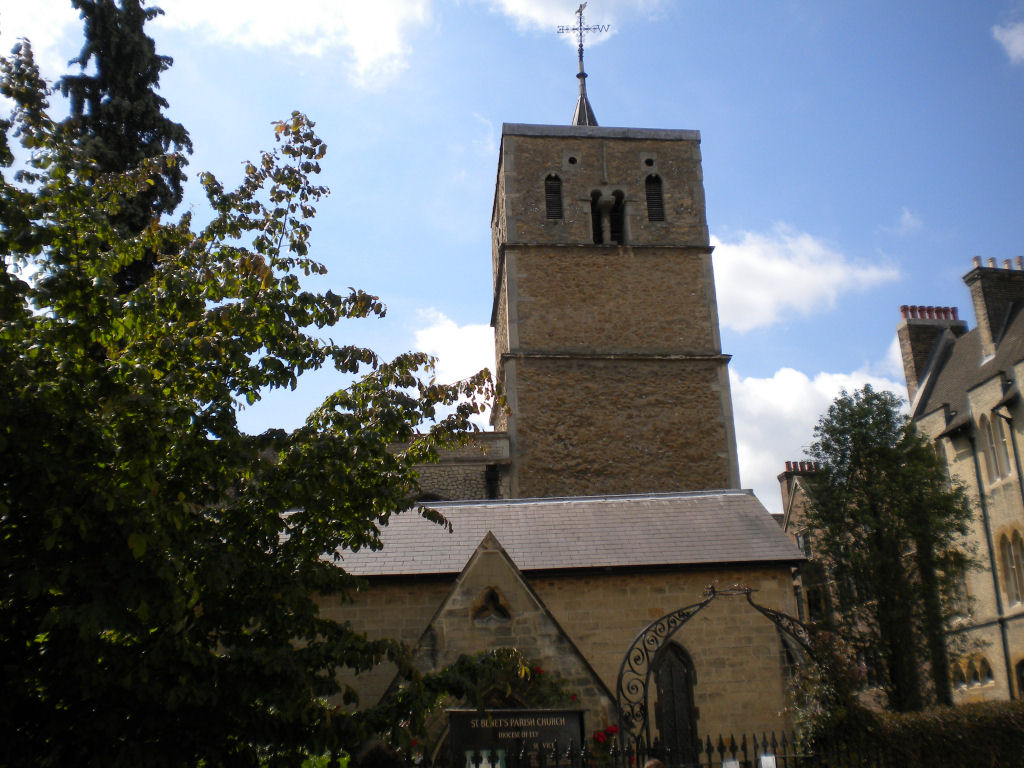 We left by the side door which was on Bene't Street. Across the street
from the Eagle Pub was the church of
St. Bene't, the oldest church in
Cambridge as well as the oldest building in Cambridge. Bene't is a
contraction of Benedict, thus th
We left by the side door which was on Bene't Street. Across the street
from the Eagle Pub was the church of
St. Bene't, the oldest church in
Cambridge as well as the oldest building in Cambridge. Bene't is a
contraction of Benedict, thus th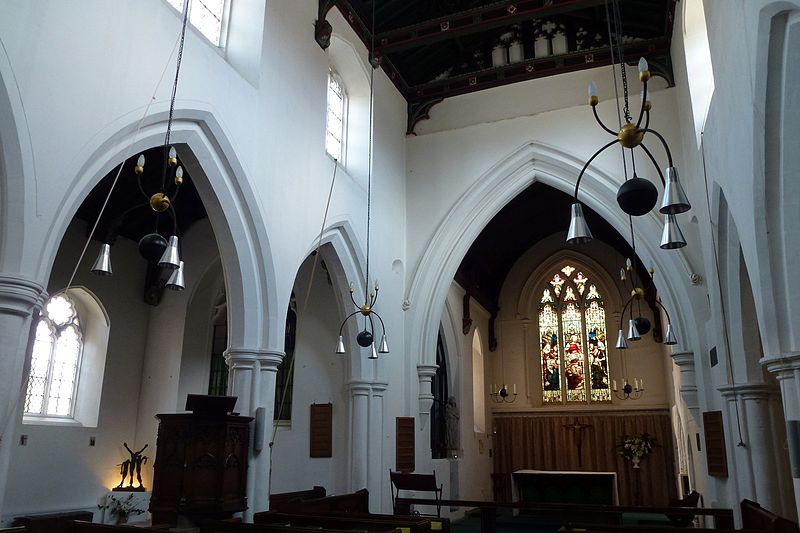 e ' in the name. St. Bene't's
Anglo-Saxon tower was built between A.D. 1000 and 1050. Inside the
church the 11th century arches supporting the tower is the most notable
feature. In the 13th century the chancel was altered. The nave and
aisles were rebuilt about 1300.
e ' in the name. St. Bene't's
Anglo-Saxon tower was built between A.D. 1000 and 1050. Inside the
church the 11th century arches supporting the tower is the most notable
feature. In the 13th century the chancel was altered. The nave and
aisles were rebuilt about 1300.
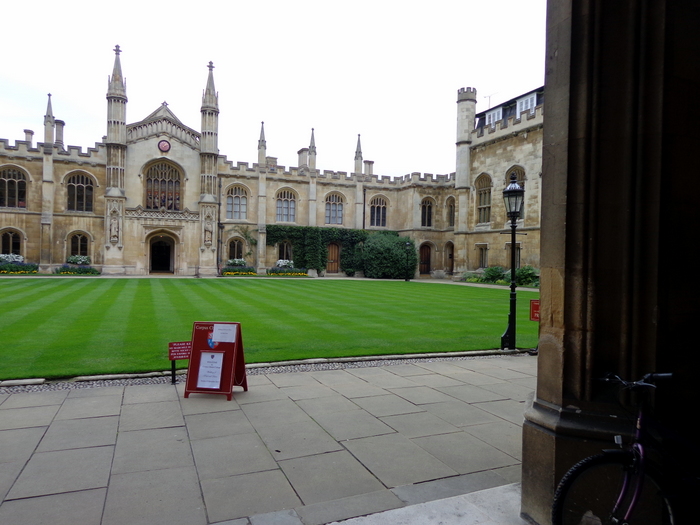 Next, we stopped in the tourist office for a map and few directions. As
we started down the main street, our first stop was
Corpus Christi
College founded in 1352 by the guilds of Corpus Christi and the Blessed
Virgin Mary. It bears the distinction of being the only Oxbridge
college founded by the townspeople. The emphasis
Next, we stopped in the tourist office for a map and few directions. As
we started down the main street, our first stop was
Corpus Christi
College founded in 1352 by the guilds of Corpus Christi and the Blessed
Virgin Mary. It bears the distinction of being the only Oxbridge
college founded by the townspeople. The emphasis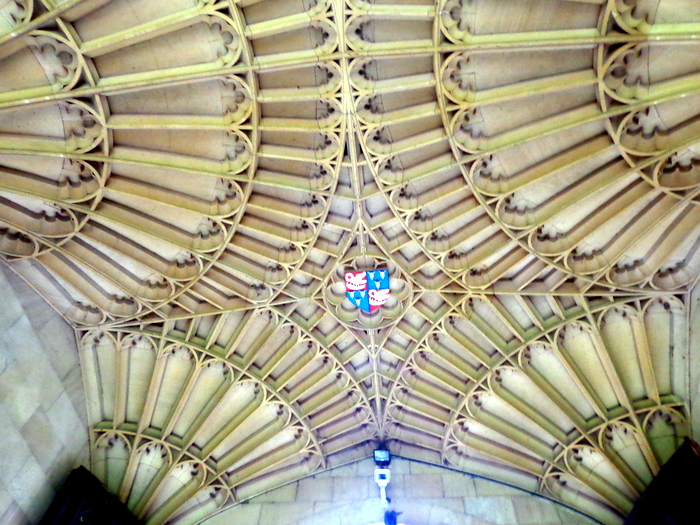 of this college is on
teaching and research. It provides an academic and residential
environment for approximately 54 fellows, 260 undergraduates, 210
graduates and employs 100 staff . We couldn't go in, but looked at the
beautiful court from behind a rope as well as the lovely ceiling of the
entrance.
of this college is on
teaching and research. It provides an academic and residential
environment for approximately 54 fellows, 260 undergraduates, 210
graduates and employs 100 staff . We couldn't go in, but looked at the
beautiful court from behind a rope as well as the lovely ceiling of the
entrance.
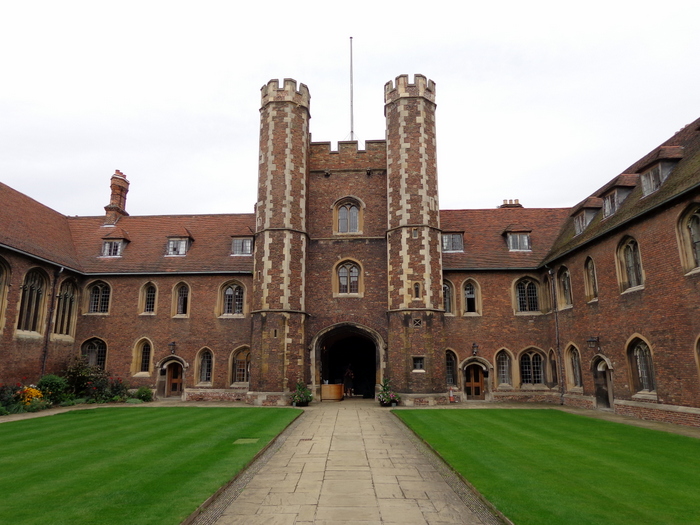 Walking further up the street, we visited Queen’s College and the famous
little wooden bridge. Queen's College is named after the patronage
bestowed by two consecutive Queens, Margaret of Anjou, wife of Henry VI,
and Elizabeth Woodville, wife of Edward IV. The college was granted is
First Charter in 1446.
Walking further up the street, we visited Queen’s College and the famous
little wooden bridge. Queen's College is named after the patronage
bestowed by two consecutive Queens, Margaret of Anjou, wife of Henry VI,
and Elizabeth Woodville, wife of Edward IV. The college was granted is
First Charter in 1446.
We pass through the entrance
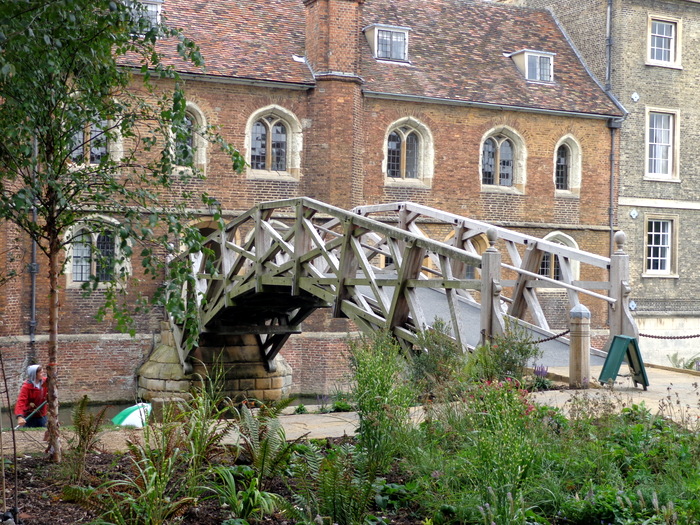 and came out near the bridge, known as the
Mathematical Bridge. The bridge was designed in 1748 and was rebuilt in
the same design in 1866 and 1905. The bridge crosses over the River Cam
which runs along the backside of the colleges – thus
and came out near the bridge, known as the
Mathematical Bridge. The bridge was designed in 1748 and was rebuilt in
the same design in 1866 and 1905. The bridge crosses over the River Cam
which runs along the backside of the colleges – thus
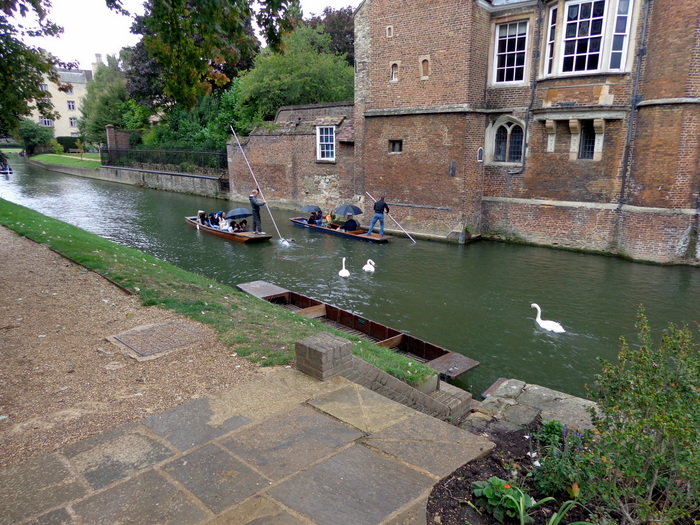 called "the Backs"
because the backs are as fine as the fronts of the building. One can
take a ride on the river in a punt. We had planned to do this but it
was rainy and had gotten cold, so we just watched others from the
bridge.
called "the Backs"
because the backs are as fine as the fronts of the building. One can
take a ride on the river in a punt. We had planned to do this but it
was rainy and had gotten cold, so we just watched others from the
bridge.
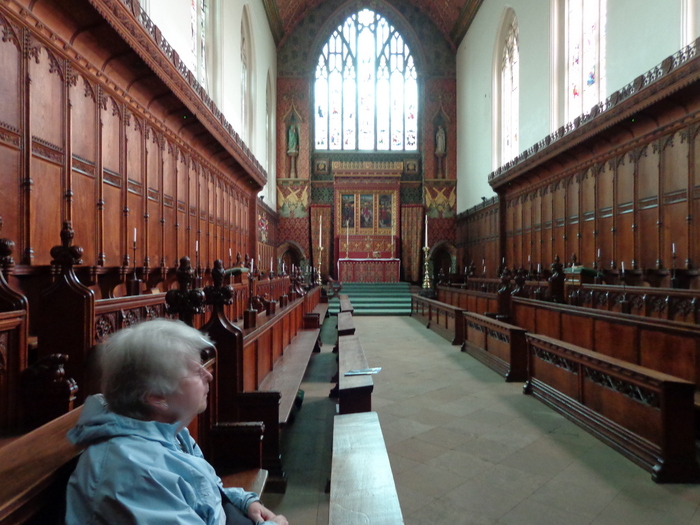
The Queen's College Chapel was a separate building. It was quite lovely on the inside.
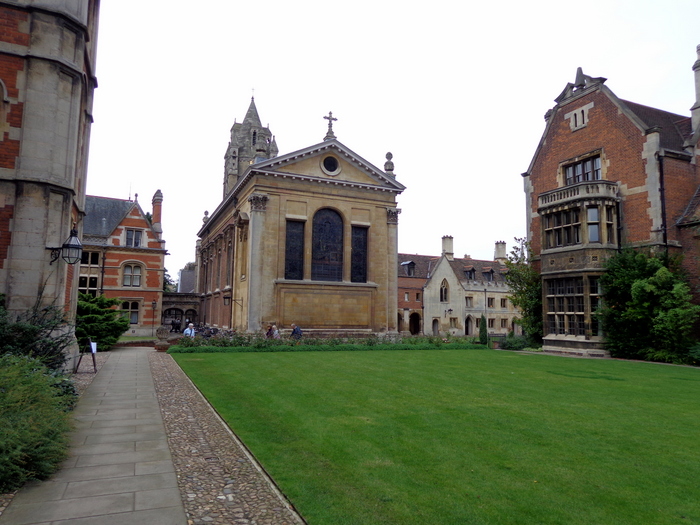 After leaving Queens College, we stopped at
Pembrook College, which is the
third oldest College of the University and has over 700 students.
Physically, it is one of the University's
After leaving Queens College, we stopped at
Pembrook College, which is the
third oldest College of the University and has over 700 students.
Physically, it is one of the University's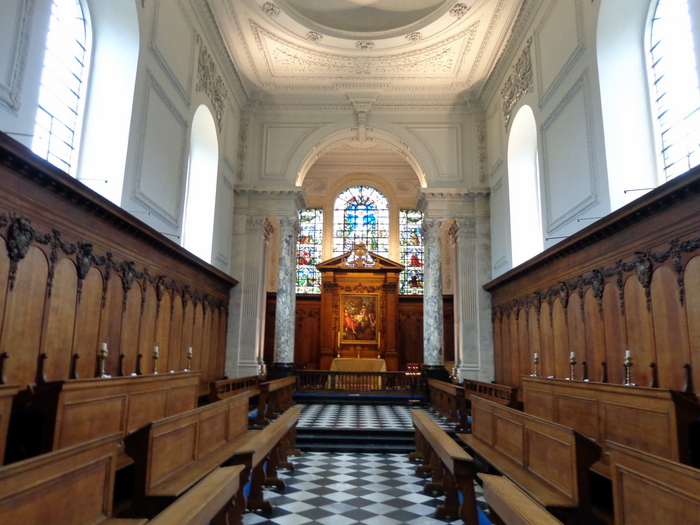 larger colleges. Pembrook is
the home of the first Chapel designed by Sir Christopher Wren, who
designed St. Paul's, London. We were able to visit this beautiful
chapel .
larger colleges. Pembrook is
the home of the first Chapel designed by Sir Christopher Wren, who
designed St. Paul's, London. We were able to visit this beautiful
chapel .
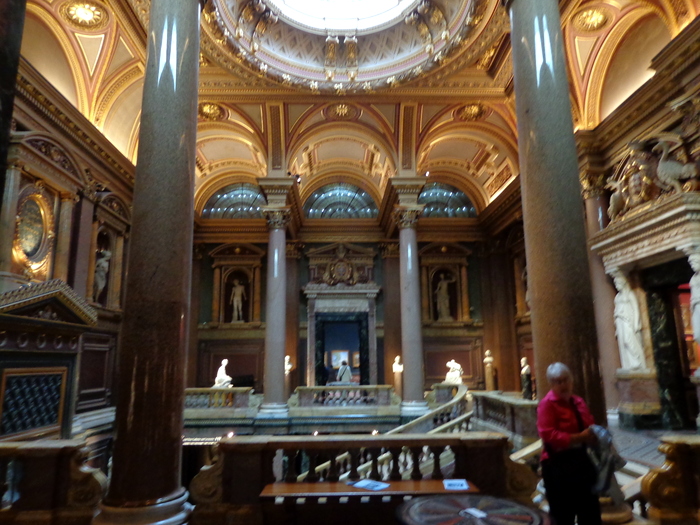 On up the road was the Fitzwilliam Museum, founded in 1816. It had a
great collection of old masters including 25 watercolors by JMW Turner
as well as works by Gainsborough, Reynolds, Constabl
On up the road was the Fitzwilliam Museum, founded in 1816. It had a
great collection of old masters including 25 watercolors by JMW Turner
as well as works by Gainsborough, Reynolds, Constabl e, Rembrandt, da
Vinci, Titian, Rubens and van Dyck. The collection of French
Impressionist included landscapes by Monet and Cézanne as well as
studies by Renoir and Degas. The Museum building itself was quite
lovely.
e, Rembrandt, da
Vinci, Titian, Rubens and van Dyck. The collection of French
Impressionist included landscapes by Monet and Cézanne as well as
studies by Renoir and Degas. The Museum building itself was quite
lovely.
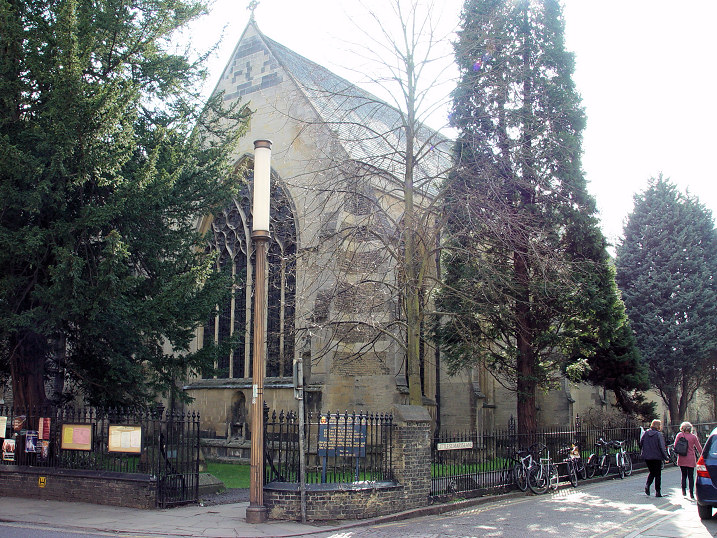 After an enjoyable time in the museum, we walked back down towards King’s
College. We passed a church called
Little St. Mary's or the Church of
St. Mary the Less, so we stopped in. There has been a place of worship
on the current site
After an enjoyable time in the museum, we walked back down towards King’s
College. We passed a church called
Little St. Mary's or the Church of
St. Mary the Less, so we stopped in. There has been a place of worship
on the current site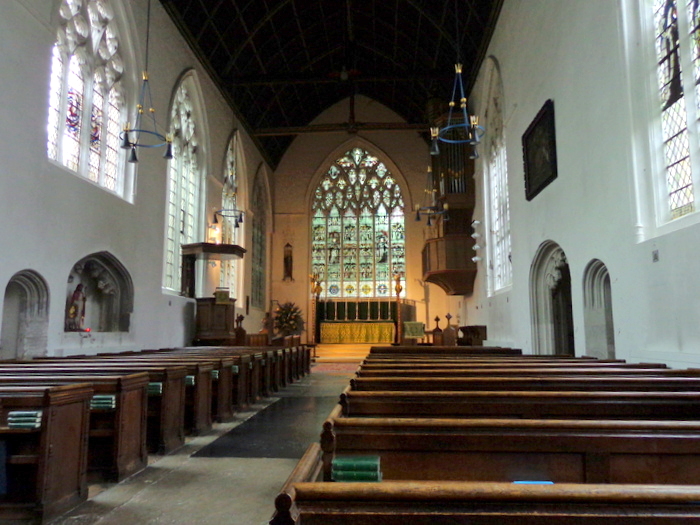 since around the 12th century. The earliest known
records of the church state that the first church here, called St. Peter
– without – Trumpington Gate was controlled by three successive
generations of the same family until 1207, after that date it was given
to the hospital of St. John the Evangelist and served by chaplains from
that foundation. The church had been restored several times, the last
was in 1880. The stained-glass windows were interesting in that the
figures were surrounded by an opaque glass.
since around the 12th century. The earliest known
records of the church state that the first church here, called St. Peter
– without – Trumpington Gate was controlled by three successive
generations of the same family until 1207, after that date it was given
to the hospital of St. John the Evangelist and served by chaplains from
that foundation. The church had been restored several times, the last
was in 1880. The stained-glass windows were interesting in that the
figures were surrounded by an opaque glass.
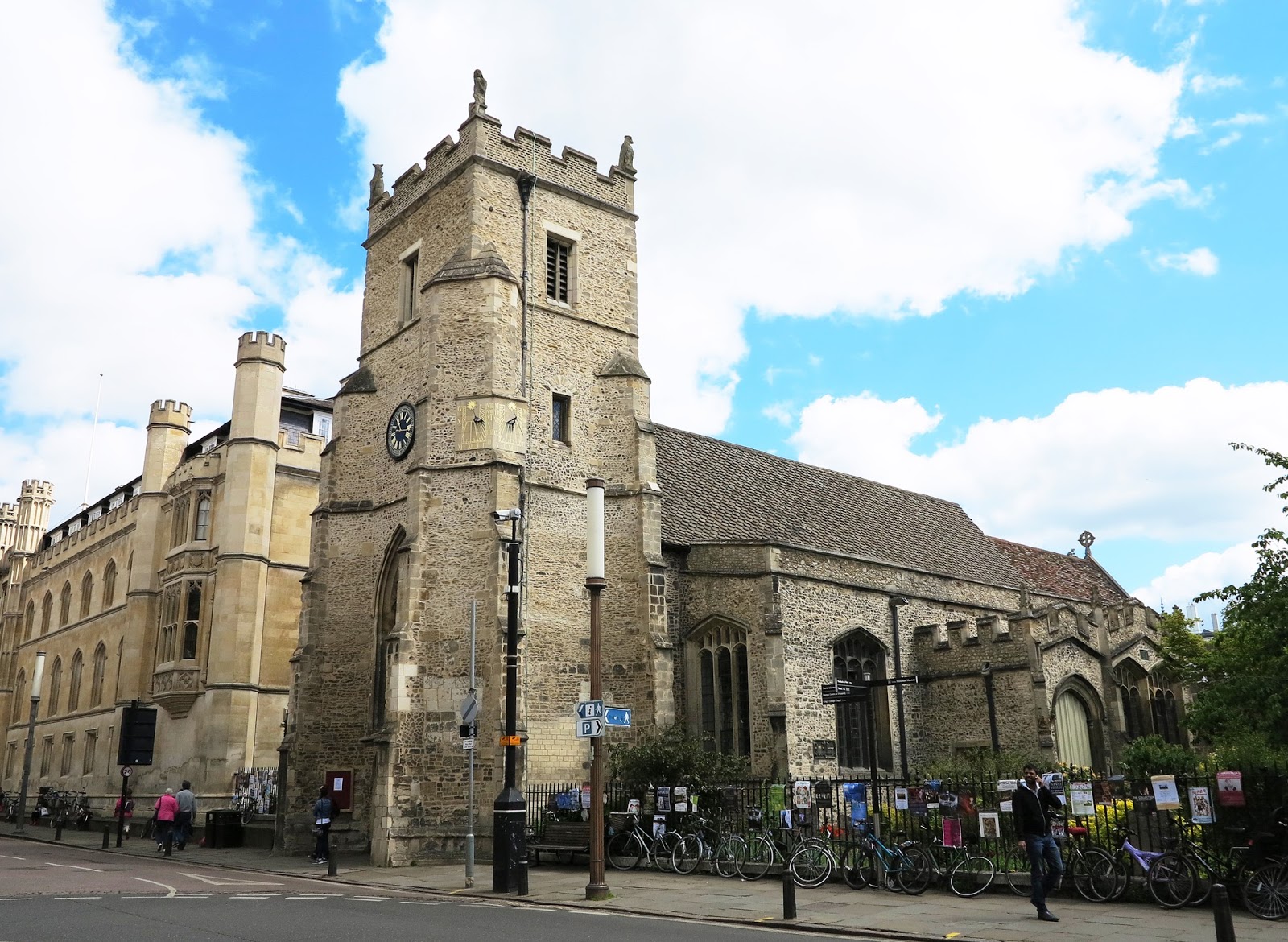 Further down the street we came to
St. Botolph's Church
which is
dedicated to St. Botolph, a seventh century abbott in East Anglia, who
is the patron saint of travelers. The church was by the South gate of
medieval Cambridge, through which travelers from London entered the
town. Norman and Saxon churches stood on the site prior to the existing
church which was built in 1350.
Further down the street we came to
St. Botolph's Church
which is
dedicated to St. Botolph, a seventh century abbott in East Anglia, who
is the patron saint of travelers. The church was by the South gate of
medieval Cambridge, through which travelers from London entered the
town. Norman and Saxon churches stood on the site prior to the existing
church which was built in 1350.
A carved Rood Screen, which separa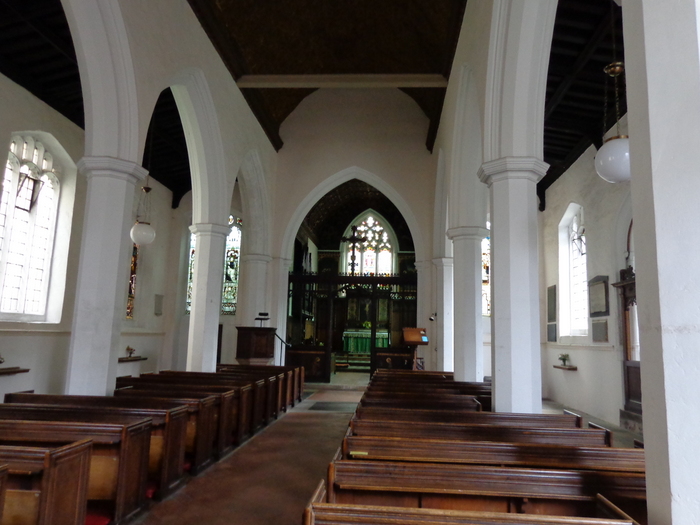 tes the nave and the choir, is now the
only medieval Rood Screen remaining in Cambridge. On it are painted
panels depicting the Angel announcing to Mary that she is to bear the
child Jesus. The font has a beautiful wooden cover and case that dates
from the time of Archbishop Laud in 1637.
tes the nave and the choir, is now the
only medieval Rood Screen remaining in Cambridge. On it are painted
panels depicting the Angel announcing to Mary that she is to bear the
child Jesus. The font has a beautiful wooden cover and case that dates
from the time of Archbishop Laud in 1637.
On the corner across from the Eagle Pub, there is an unusual display in
a glass case on the corner of a building. It is called the Corpus
Clock. It is a unique and strange device for the measurement of time. It
was invented, designed and given to Corpus Christi College, Cambridge,
by Dr John C Taylor. The Clock is a "remarkable mixture of very modern
design and an ancient setting; of precision engineering and engaging
whimsy; of utterly traditional clockwork (quite literally) and
unexpected electronic invention; of vast size and extreme delicacy of
movem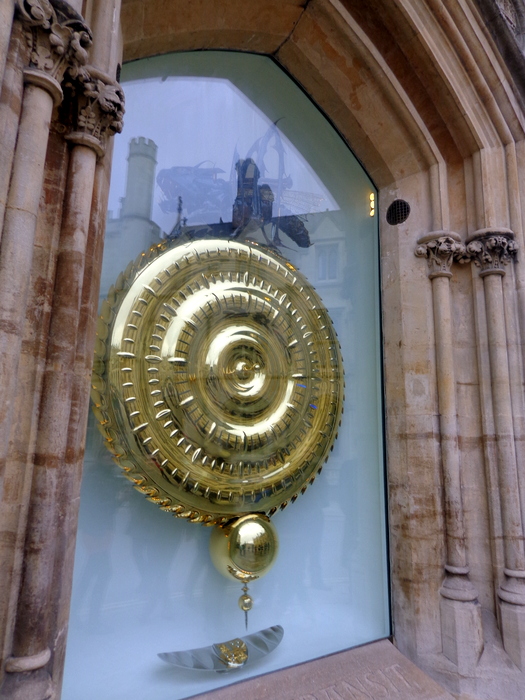 ent; of unceasing life and imminent death; and it tells the time
with absolute exactness and breathtaking unpredictability" .
ent; of unceasing life and imminent death; and it tells the time
with absolute exactness and breathtaking unpredictability" .
The face of the clock is plated in pure gold and is made to resemble radiating ripples, as if a stone had dropped into the middle of a pond of liquid metal. Above the universe and dominating the clock is an extraordinary monster. Dr John C Taylor uses the word ‘Chronophage’ for this beast, like a giant grasshopper, meaning ‘time-eater’, for that is what it seems to be doing, devouring each minute as it passes. The Corpus Clock has no hands, or digital numbers. Time is shown by concentric orbits of what appear to be flashing blue lights, darting or progressing at different rates around the circumference of the clock face.
We had a 6:30 dinner reservation in a nice restaurant across the street
from King’s College. It was 3:30, and getting very cold and windy. We
had one more church we wanted to see, and decided we didn’t want to hang
around for 3 hrs. We were both getting rather tired and very cold. We
were supposed to have a bad storm, but it just rained…what else is new.
I thought it was cold enough to snow .
.
The Church of the Holy Sepulchre, known locally as The Round Church. It
is one of the four medieval round churches still in use in England. The
church was built around 1130, its shape being inspired by the rotunda in
the church of the Holy Sepulcher, Jerusalem. It consisted of a
round nave and ambulatory, and a short chancel. During the 15th century
the Norman style windows in the nave
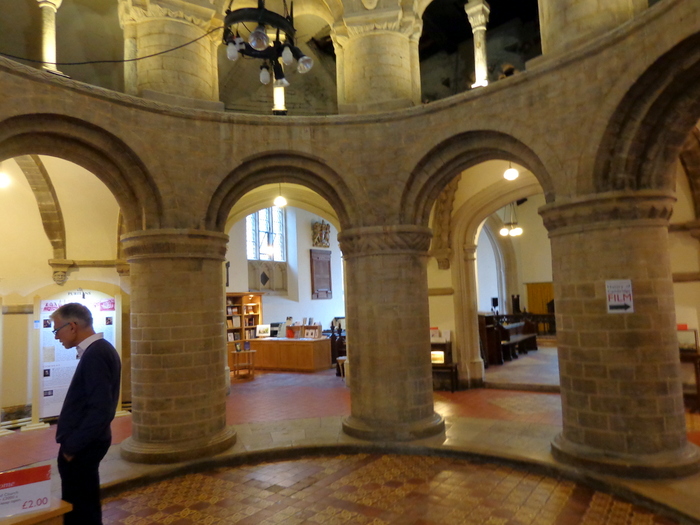 were replaced by larger Gothic
style windows. The carvings of angels in the roofs of the chancel and
aisle were added. A polygonal bell-storey was built over the nave.
were replaced by larger Gothic
style windows. The carvings of angels in the roofs of the chancel and
aisle were added. A polygonal bell-storey was built over the nave.
By the 19th century the church was in a poor state of repair. Part of the ambulatory collapsed in 1841. It is the second oldest building in Cambridge. It is a Christian Education Center. We watched a 20 minute video on the founding and growth of Cambridge and the University.
Afterward, we found at tea room and had tea and a piece of cake each. They called a taxi for us to take us back to the train station. We got there just in time to catch the 5 pm train.
We walked back to our Inn,
an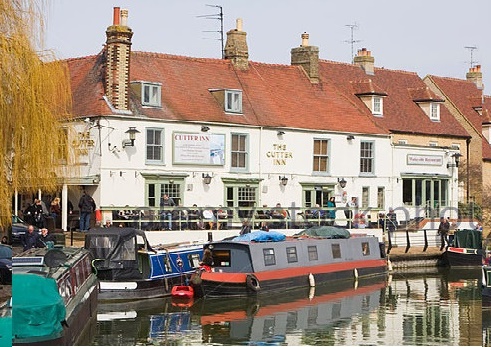 d stopped at the Cutter Inn restaurant across from us, and made reservations for
7:30. As we walked across the street, it started pouring.
d stopped at the Cutter Inn restaurant across from us, and made reservations for
7:30. As we walked across the street, it started pouring.
We wanted to eat lightly. They had a chicken pot pie on the menu so we
thought it would be small, so we had a bowl of potato and leek soup
which filled us up. Then they brought the main course. There was a
large pot pie plus on the plate were potatoes, carrots, broccoli,
cauliflowe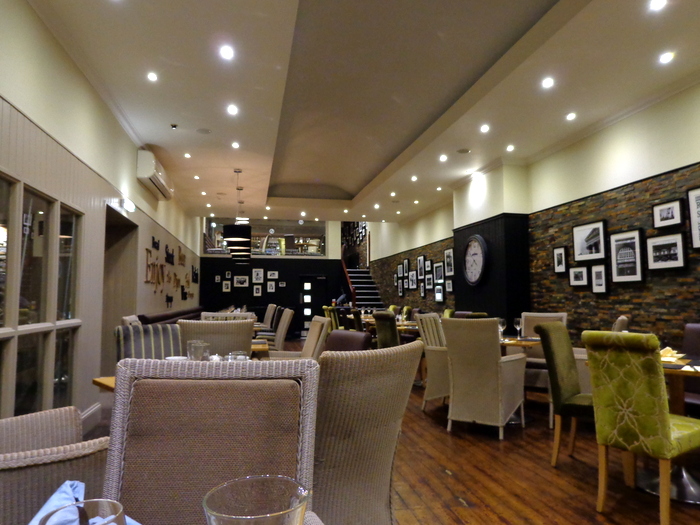 r, and snap beans. We each ate about half of the pie and
very little of the veggies. We were really full. There were very few
people in the restaurant.
r, and snap beans. We each ate about half of the pie and
very little of the veggies. We were really full. There were very few
people in the restaurant.
After dinner, we had to pack for our 4 hour trip to Worchester. We have enjoyed being by the river in Ely, we were in a ‘quaint’ spot.
NEXT DAY
PREFACE
Day 1 -Arrival in Edinburgh
Day 2 - Edinburgh
Day 3- Edinburgh to Inchcolm Abbey
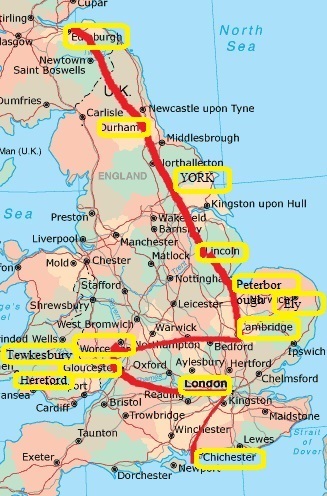
Day 4 - Edinburgh to Melrose & Rosslyn
DAY 5 - Edinburgh
DAY 6 - Edinburgh
DAY 7 - York
DAY 8 - Durham
DAY 9 -York
DAY 10 - Lincoln
DAY 11 -Ely
DAY 12 - Peterborough
DAY 13 - Cambridge
DAY 14 - Ely to Worchester
DAY 15 - Tewkesbury and Gloucester
DAY 16 - Hereford
DAY l7 - London
DAY 18 - London
DAY 19 - London
DAY 20 - London to Guildford, Chichester, Midhurst
DAY 21 - London OUR LAST DAY
HOME
